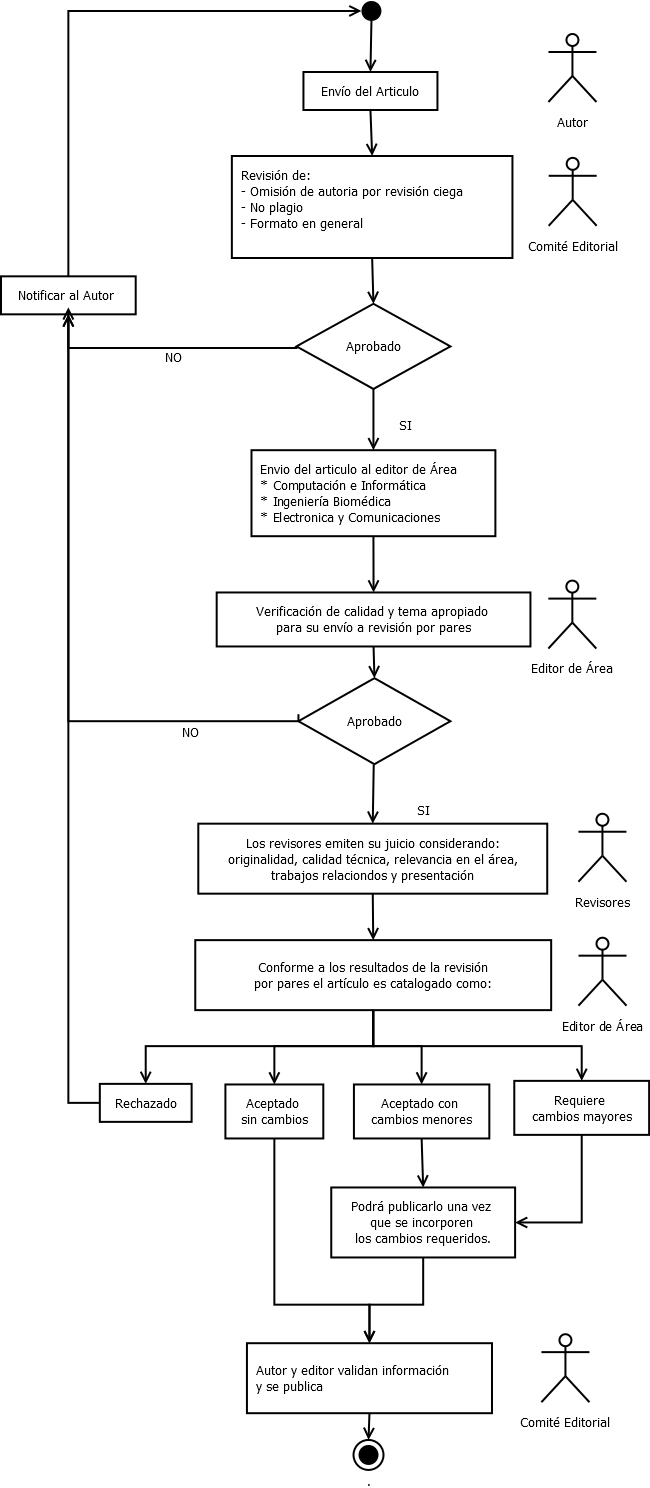Authors’ Guide
Scope
The subjects should be of interest for the research or technology development community in any of these areas: Computer Sciences, IT, Biomedical engineering, Telecommunications or Electronics.
Types of the received articles:
Scientific or technological research article
In which it is informed, in a detailed form, of original relevant results from scientific research or technological development. Their usual structure has four sections: introduction, methods, results and conclusions.
Reviewing article
Document consequence of literature review where results, from published or unpublished research, of a specific science or technology field, are analyzed and systematized; with the purpose of informing of the advances and development tendencies in the field. They are characterized by a careful biographic selection.
Reflection article
Papers with an analytic perspective, critical or interpretative, about the results of a specific research or technological development theme, from the author or others, for which the author carry out a methodical follow-up in order to present: consistency or inconsistencies, an extension, a modification or the proposition of a new perspective.
Policies for the Submission of Articles
Contributions are considered for publication when they have not been previously published, and are not currently submitted for its publications on any other media.
The acceptance is conditioned to the results of a double blind peer-reviewing process of at least two experts that can be of external institutions.
Reviewers consider the relevance of the paper for the scientific and technology development community, same as its quality.
No charge in the publishing process.
Editorial Process +
Publishing dates: May 13th and November 13th
The process takes a time approximately from 3 to 6 months, from the paper reception to its publishing
The journal numbers are published in November and May. Accepted contributions submitted before Augusto 15th will be published on the November number, and accepted contributions submitted before February 15th will be published in the May number.
Copyrights and author responsibilities:
Responsibilities and Copyrights:
The sending of the article implies the acceptance by the authors that the dissemination and distribution rights will be the property of the CUCEI of the University of Guadalajara. The authors will maintain property rights that do not correspond to those of the publication of the work, such as patent rights. Likewise, the authors may reuse portions of the work in other documents and reproduce it for personal use. Download publication agreement.
It is necessary for each Author to attach their publication agreement after all revisions.
The authors are responsible for the accuracy of the information contained in the article, the ideas and opinions expressed therein, as well as access to other websites contained therein.
Prior to publication, authors are responsible for obtaining copyright permission if their illustrations, tables, or extensive quotations from the material have been published elsewhere. Authors must obtain permission to reproduce from both the author and the source that published it.
ReCIBE is committed to respecting and complying with the rules of ethical conduct at all stages of the publication process. In this regard, we closely follow the Publication Ethics Committee (COPE), which sets the standards and provides guidelines to follow in order to meet these requirements.
Manuscript Preparation
Important note. The review is double-blind, the document for review must not have information from the authors, self-references must be presented as references to third parties.
The document can be written in Spanish or English, or in both versions.
Submitted for your review in PDF format.
Document title. Trying to be as concise as possible in Spanish and English.
Summary. With a maximum length of 250 words, briefly presenting objectives, methodology, and, if applicable, results and their importance. It should not contain references in Spanish and English.
Keywords. A minimum of three and a maximum of eight keywords in Spanish and English.
Text. 10 point Arial font, single spaced, single column, left justified.
Sections and subsections. They must be numbered using the decimal format.
Tables and Figures. Numbered in consecutive order according to how they appear in the document. The description must go at the bottom starting with the legend Table 1. Descriptive text or Figure 1. Descriptive text
The Tables and the Figures. They must appear in the manuscript in the place where they will be published, in the size in which they are to appear within the margins of the document, and each one of them must be referenced in the text. Make sure your content is fully visible.
equations. They must be numbered in consecutive order as they appear in the text, with the number in parentheses on the right side of the equation. Make sure they are left as graphics with a resolution of 600 dpi.
Video or audio material. If you want to include this type of material, you should mention it in the text. The maximum recommended size is 10-12 Mb and a maximum of two files will be received in mpg, qt or mov video format and wav, mp3 or wma audio.
Footnotes. Use them only when they are essential to present documentation or explanatory material whose inclusion in the text would be distracting. They must be numbered consecutively and placed at the end of the Text and not at the end of each page.
References. References must be in APA format www.apastyle.org
Important note. The review is double-blind, the document for review must not have information from the authors, self-references must be presented as references to third parties.
Extension. There is no minimum or maximum extension size as long as what authors write is important. However, if the size of the document exceeds 30 pages, including illustrations and references, you must briefly justify in writing why it is not advisable to shorten your article.



